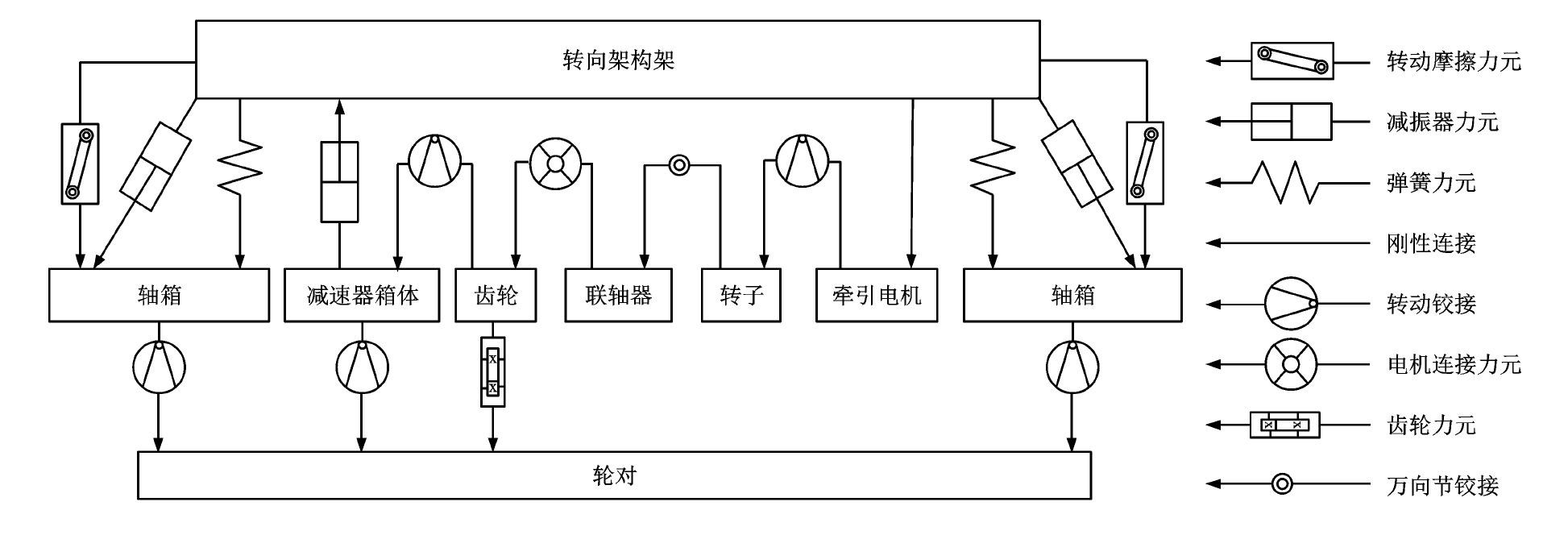Research on wheel wear under locomotive traction condition
Article Text (Baidu Translation)
-
摘要: 以某正在运行的C0-C0轴式电力机车为研究对象, 考虑了机车传动系统的影响, 基于Archard磨耗模型, 建立了电力机车的车轮磨耗计算模型, 研究了恒速与起动工况下车轮的磨耗, 根据某实际线路计算车轮磨耗, 并与实测数据进行对比, 研究了机车正常运行过程中出现的轮缘非正常磨耗。分析结果表明: 当车辆恒速运行2.6×105 km, 牵引力由40kN增大到120kN和由120kN增大到200kN时, 磨耗分别增加了0.74、1.74mm, 因此, 随着牵引力增大磨耗急剧增加; 机车起动过程中增加牵引力可以获得更大的加速度, 随着牵引力增大, 蠕滑率明显增大, 因此, 增加牵引力可节约运行时间, 但同时会产生更大磨耗; 通过与车轮磨耗实测数据对比, 车轮磨耗计算模型较为准确, 在踏面处仿真计算结果与实测结果具有很好的一致性; 由于车轮磨耗计算模型未考虑材料的塑性流动与道岔的影响, 在轮缘处的仿真结果与实测结果有一定的差异; 降低二位轮对横动量和轨侧润滑能够大幅降低车轮磨耗, 当二位轮对横动量由15mm降低为10mm时, 二位轮对累积磨耗降低了15.4%;轨侧润滑后一~三位轮对最大累积磨耗分别降低了13.40%、21.32%、6.46%。Abstract: Taking a running C0-C0 shaft type electric locomotive as research object, the wheel wear calculation model of electric locomotive was established based on the Archard wear model, and the influence of locomotive drive system was considered in the model.The wheel wears under constant speed and starting conditions were studied.The wheel wear was calculated according to a actual line, and was compared with the measured data.The abnormal wear of wheel flange during the normal operation of locomotive was studied.Analysis result shows that when the vehicle runs 2.6×105 km at a constant speed, and the traction forces increase from 40 kN to120 kN and 120 kN to 200 kN, the wears increase by 0.74 mm and 1.74 mm respectively, so the wear increases rapidly with the increase of traction force.Increasing the traction force during locomotive starting process can obtain greater acceleration.With the increase of traction force, the creep rate increases obviously.Increasing the traction force can save running time, but wear increases at the same time.Compared with the measured data of wheel wear, the wheel wear calculation model is comparatively accurate, and the simulation result at the tread surface is ingood consistency with the measured result.Because the plastic flow of materials and the influence of railway switch are not considered in the wheel wear calculation model, the simulation result of wheel rim has difference with the measured result.The wheel wear greatly reduces when reducing the transverse momentum of second wheelset and rail-side lubrication. When the transverse momentum of second wheelset reduces from 15 mm to 10 mm, the cumulative wear of middle wheelset reduces by 15.4%.After rail-side lubrication, the maximum cumulative wears of the first wheelset, the second wheelset and the third wheelset decrease by 13.40%, 21.32%, 6.46%, separately.
-
Key words:
- locomotive engineering /
- wheel wear /
- traction force /
- creep rate /
- drive system /
- abnormal wear of wheel flange
-
-
[1] 丁军君, 孙树磊, 李芾, 等. 重载货车车轮磨耗仿真[J]. 交通运输工程学报, 2011, 11 (4): 56-60. http://transport.chd.edu.cn/article/id/201104009DING Jun-jun, SUN Shu-lei, LI Fu, et al. Simulation of wheel wear for heavy haul freight car[J]. Journal of Traffic and Transportation Engineering, 2011, 11 (4): 56-60. (in Chinese). http://transport.chd.edu.cn/article/id/201104009 [2] 谭立成. 长波长直线钢轨交替侧磨和机车轮缘磨耗的形成和防治[J]. 中国铁道科学, 2002, 23 (4): 67-71. doi: 10.3321/j.issn:1001-4632.2002.04.014TAN Li-cheng. Long wavelength rail alternative side wear and locomotive flange wear on tangent[J]. China Railway Science, 2002, 23 (4): 67-71. (in Chinese). doi: 10.3321/j.issn:1001-4632.2002.04.014 [3] 杨阳, 李芾, 张茂松, 等. 槽型轨磨耗演变过程数值模拟[J]. 铁道科学与工程学报, 2016, 13 (8): 1607-1612. doi: 10.3969/j.issn.1672-7029.2016.08.023YANG Yang, LI Fu, ZHANG Mao-song, et al. Numerical simulation of groove track wear evolution[J]. Journal of Railway Science and Engineering, 2016, 13 (8): 1607-1612. (in Chinese). doi: 10.3969/j.issn.1672-7029.2016.08.023 [4] 神圣, 张军, 孙传喜, 等. 磨耗状态下机车车轮与曲线钢轨的接触分析[J]. 铁道学报, 2012, 34 (6): 15-19. doi: 10.3969/j.issn.1001-8360.2012.06.003SHEN Sheng, ZHANG Jun, SUN Chuan-xi, et al. Analysis on contact between worn wheel and rail on curve[J]. Journal of the China Railway Society, 2012, 34 (6): 15-19. (in Chinese). doi: 10.3969/j.issn.1001-8360.2012.06.003 [5] 郑箭锋. HXD3C型机车在鹰厦线小半径曲线轮缘磨耗原因分析[J]. 机车电传动, 2013 (3): 94-96. doi: 10.3969/j.issn.1000-128X.2013.03.027ZHENG Jian-feng. HXD3Clocomotive in Ying-Xia Line of small radius curve wheel flange wear cause analysis[J]. Electric Drive for Locomotives, 2013 (3): 94-96. (in Chinese). doi: 10.3969/j.issn.1000-128X.2013.03.027 [6] BRAGHIN F, BRUNI S, RESTA F. Wear of railway wheel profiles: a comparison between experimental results and a mathematical model[J]. Vehicle System Dynamics, 2002, 37 (S1): 478-489. [7] ZOBORY I. Prediction of wheel/rail profile wear[J]. Vehicle System Dynamics, 1997, 28 (2/3): 221-259. [8] JENDEL T. Prediction of wheel profile wear-comparisons with field measurements[J]. Wear, 2002, 253 (1): 89-99. [9] DING Jun-jun, LI Fu, HUANG Yun-hua, et al. Application of the semi-Hertzian method to the prediction of wheel wear in heavy haul freight car[J]. Wear, 2014, 314 (1/2): 104-110. [10] TAO V C, 李芾, 丁军君, 等. 基于Zobory模型的机车车轮磨耗研究[J]. 铁道机车车辆, 2015, 35 (3): 6-10. doi: 10.3969/j.issn.1008-7842.2015.03.02TAO V C, LI Fu, DING Jun-jun, et al. Research on wheel wear of locomotive based on Zobory's model[J]. Railway Locomotive and Car, 2015, 35 (3): 6-10. (in Chinese). doi: 10.3969/j.issn.1008-7842.2015.03.02 [11] 罗仁, 曾京, 戴焕云, 等. 高速列车车轮磨耗预测仿真[J]. 摩擦学学报, 2009, 29 (6): 551-558. doi: 10.3321/j.issn:1004-0595.2009.06.011LUO Ren, ZENG Jing, DAI Huan-yun, et al. Simulation on wheel wear prediction of high-speed train[J]. Tribology, 2009, 29 (6): 551-558. (in Chinese). doi: 10.3321/j.issn:1004-0595.2009.06.011 [12] LIU B, MEI T X, BRUNI S. Design and optimisation of wheel-rail profiles for adhesion improvement[J]. Vehicle System Dynamics, 2016, 54 (3): 429-444. doi: 10.1080/00423114.2015.1137958 [13] WANG W J, WANG H, WANG H Y, et al. Sub-scale simulation and measurement of railroad wheel/rail adhesion under dry and wet conditions[J]. Wear, 2013, 302 (1/2): 1461-1467. [14] CARTERF W. On the action of a locomotive driving wheel[J]. Proceedings of the Royal Society of London A: Mathematical, Physical and Engineering Sciences, 1926, 112 (760): 151-157. [15] 林凤涛. 高速列车车轮摩耗及型面优化研究[D]. 北京: 中国铁道科学研究院, 2014.LIN Feng-tao. Research on wheel wear and wheel profile optimization of high speed train[D]. Beijing: China Academy of Railway Sciences, 2014. (in Chinese). [16] ARCHARD J F, HIRST W. The wear of metals under unlubricated conditions[J]. Proceedings of the Royal Society of London A: Mathematical, Physical and Engineering Sciences, 1956, 236 (1206): 397-410. doi: 10.1098/rspa.1956.0144 [17] SAIDOVA A, ORLOVA A. Refining the parameters of Archard's wear model for calculating wear of wheels applied for 25tper axle freight wagons on Russian railways[J]. Vehicle System Dynamics, 2014, 52 (S1): 3-15. [18] 李霞, 金学松, 胡东. 车轮摩耗计算模型及其数值方法[J]. 机械工程学报, 2009, 45 (9): 193-200.LI Xia, JIN Xue-song, HU Dong. Theoretical model and numerical method of wheel profile wear[J]. Journal of Mechanical Engineering, 2009, 45 (9): 193-200. (in Chinese). [19] KALKERJ J. Survey of wheel-rail rolling contact theory[J]. Vehicle System Dynamics, 1979, 8 (4): 317-358. doi: 10.1080/00423117908968610 [20] KALKERJ J. A fast algorithm for the simplified theory of rolling contact[J]. Vehicle System Dynamics, 1982, 11 (1): 1-13. doi: 10.1080/00423118208968684 [21] 李志勇, 文睿, 危韧勇. 基于径向基神经网络的机车牵引能耗计算模型[J]. 铁道学报, 2011, 33 (9): 27-30. https://www.cnki.com.cn/Article/CJFDTOTAL-TDXB201109005.htmLI Zhi-yong, WEN Rui, WEI Ren-yong. Study on locomotive traction energy consumption calculation based on RBF neural network[J]. Journal of the China Railway Society, 2011, 33 (9): 27-30. (in Chinese). https://www.cnki.com.cn/Article/CJFDTOTAL-TDXB201109005.htm [22] 刘宏友, 王为, 李亨利, 等. 青藏客车轮缘异常磨耗分析[J]. 铁道车辆, 2008, 46 (5): 1-6. https://www.cnki.com.cn/Article/CJFDTOTAL-TDCL200805002.htmLIU Hong-you, WANG Wei, LI Heng-li, et al. Analysis of abnormal wear of wheel flanges for Qingzang passenger cars[J]. Rolling Stock, 2008, 46 (5): 1-6. (in Chinese). https://www.cnki.com.cn/Article/CJFDTOTAL-TDCL200805002.htm [23] 徐军帅, 徐华伟, 姜乃中. HXD3机车轮缘非正常磨耗问题的探讨[J]. 上海铁道科技, 2013 (2): 65-67. https://www.cnki.com.cn/Article/CJFDTOTAL-TDKJ201302034.htmXU Jun-shuai, XU Hua-wei, JIANG Nai-zhong. Discussion on HXD3locomotive wheel flange abnormal wear issues[J]. Shanghai Railway Science and Technology, 2013 (2): 65-67. (in Chinese). https://www.cnki.com.cn/Article/CJFDTOTAL-TDKJ201302034.htm [24] 姚汤伟, 陈跃年, 朱建昌. 干式润滑方式在机车轮缘润滑中的应用[J]. 润滑与密封, 2006 (8): 179-180. doi: 10.3969/j.issn.0254-0150.2006.08.055YAO Tang-wei, CHEN Yue-nian, ZHU Jian-chang. Application of dry lubrication method in locomotive wheel flange lubrication[J]. Lubrication Engineering, 2006 (8): 179-180. (in Chinese). doi: 10.3969/j.issn.0254-0150.2006.08.055 [25] OTTE R. 采用轮缘润滑装置降低轨道磨损[J]. 城市轨道交通研究, 2006, 9 (5): 58-59. https://www.cnki.com.cn/Article/CJFDTOTAL-GDJT200605018.htmOTTE R. Roller lubrication system is adopted to reduce orbital wear[J]. Urban Mass Transit, 2006, 9 (5): 58-59. (in Chinese). https://www.cnki.com.cn/Article/CJFDTOTAL-GDJT200605018.htm [26] SHEN Z Y, HEDRICK J K. The influence of rail lubrication on freight car wheel/rail wear rates[J]. Vehicle System Dynamics, 1986, 15 (S1): 523-536. -





 下载:
下载:















